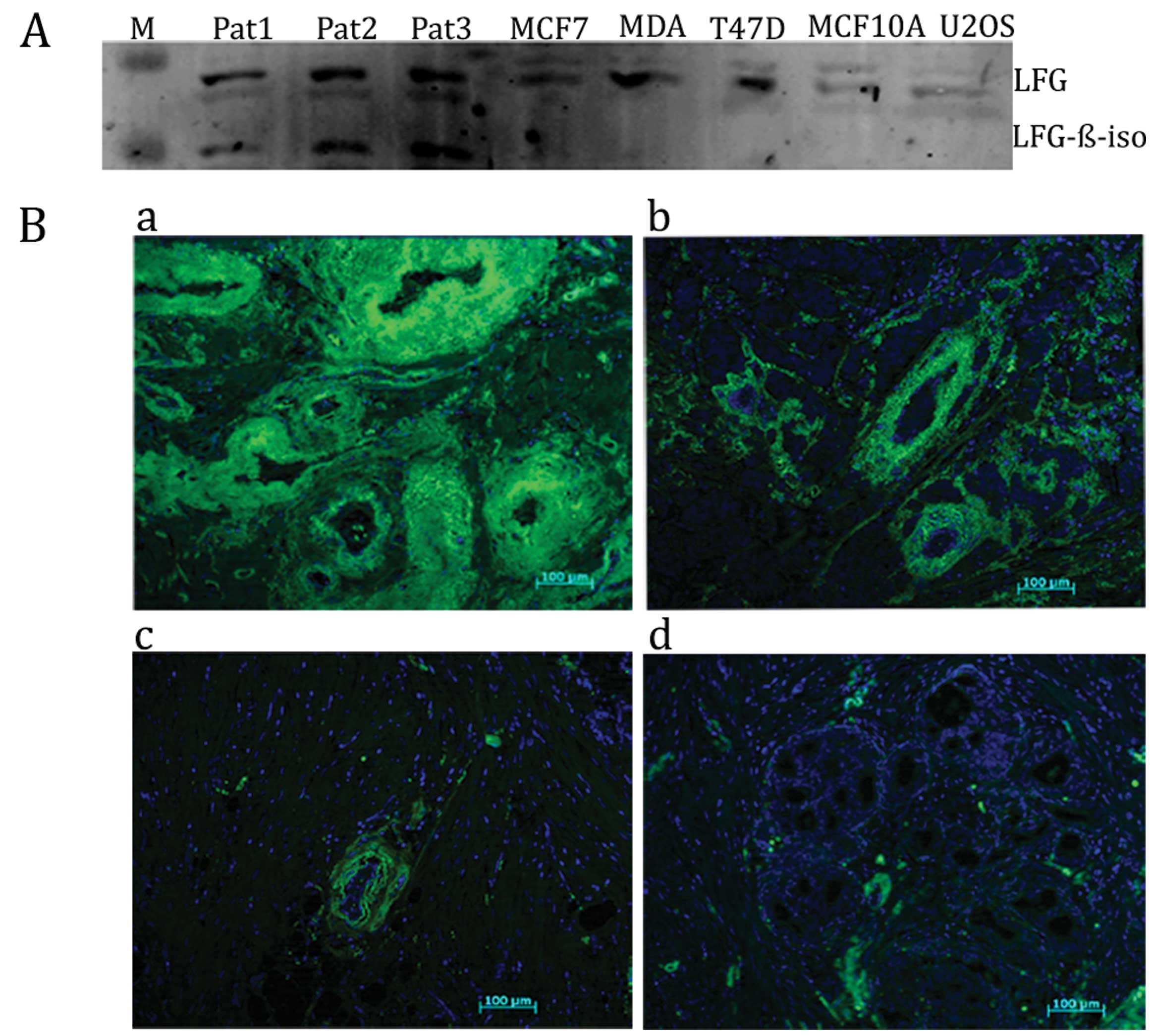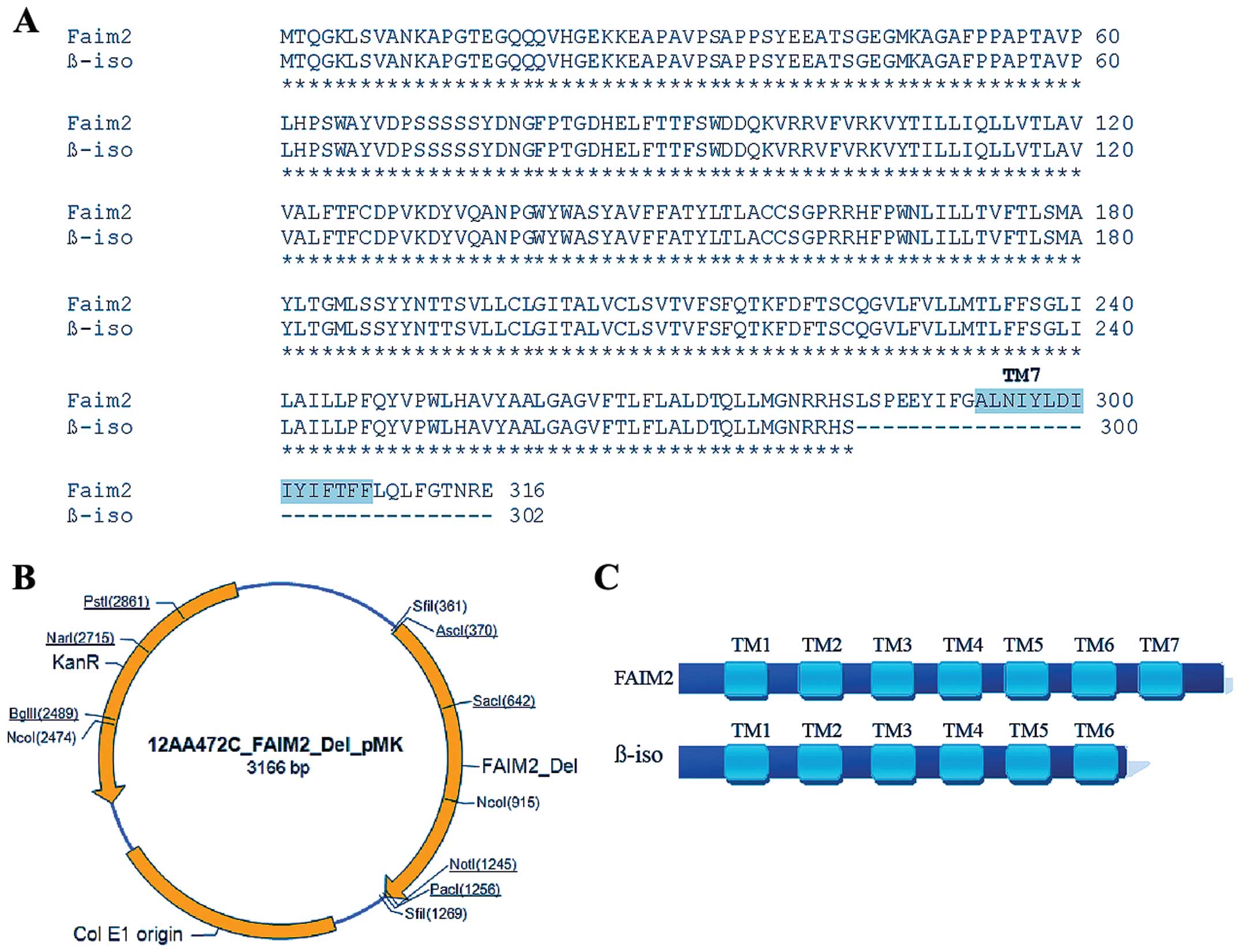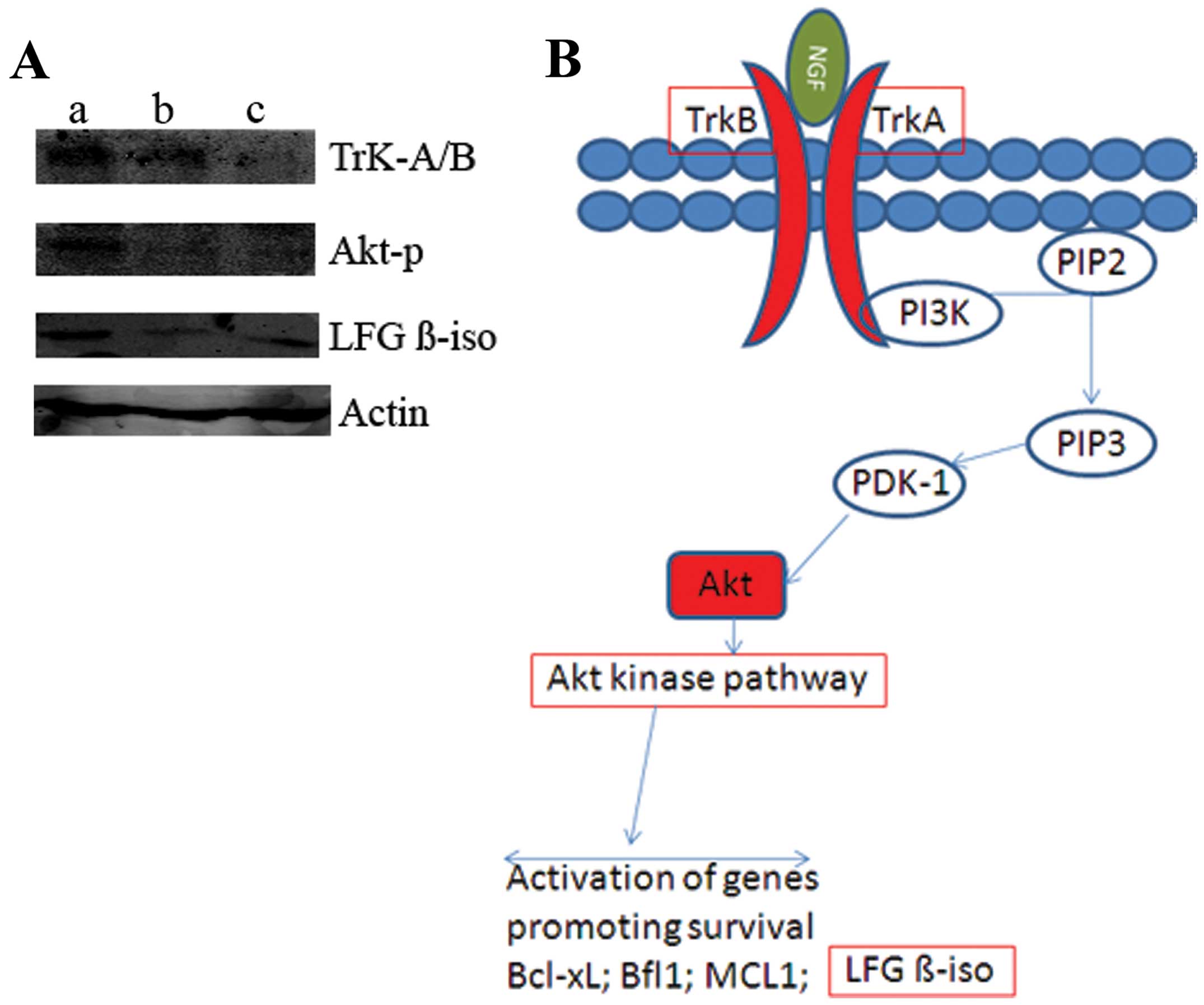|
1
|
Somia NV, Schmitt MJ, Vetter DE, Van
Antwerp D, Heinemann SF and Verma IM: LFG: an anti-apoptotic gene
that provides protection from Fas-mediated cell death. Proc Natl
Acad Sci USA. 96:12667–12672. 1999. View Article : Google Scholar : PubMed/NCBI
|
|
2
|
Fernandez M, Segura MF, Sole C, Colino A,
Comella JX and Cena V: Lifeguard/neuronal membrane protein 35
regulates Fas ligand-mediated apoptosis in neurons via microdomain
recruitment. J Neurochem. 103:190–203. 2007.PubMed/NCBI
|
|
3
|
Bucan V, Reimers K, Choi CY, Eddy MT and
Vogt PM: The anti-apoptotic protein lifeguard is expressed in
breast cancer cells and tissues. Cell Mol Biol Lett. 15:296–310.
2010. View Article : Google Scholar : PubMed/NCBI
|
|
4
|
Reimers K, Choi CY, Bucan V and Vogt PM:
The Bax inhibitor-1 (BI-1) family in apoptosis and tumourigenesis.
Curr Mol Med. 8:148–156. 2008. View Article : Google Scholar : PubMed/NCBI
|
|
5
|
Reimers K, Choi CY, Bucan V and Vogt PM:
The growth-hormone inducible transmembrane protein (Ghitm) belongs
to the Bax inhibitory protein-like family. Int J Biol Sci.
3:471–476. 2007. View Article : Google Scholar : PubMed/NCBI
|
|
6
|
Bucan V, Choi CY, Lazaridis A, Vogt PM and
Reimers K: Silencing of anti-apoptotic transmembrane protein
lifeguard sensitizes solid tumour cell lines MCF-7 and SW872 to
peri-fosine-induced cell death activation. Oncol Lett. 2:419–422.
2011.PubMed/NCBI
|
|
7
|
Nguyen A, Rosner A, Milovanovic T, et al:
Wnt pathway component LEF1 mediates tumour cell invasion and is
expressed in human and murine breast cancers lacking ErbB2
(her-2/neu) overexpression. Int J Oncol. 27:949–956.
2005.PubMed/NCBI
|
|
8
|
Hu L, Smith TF and Goldberger G: LFG: a
candidate apoptosis regulatory gene family. Apoptosis.
14:1255–1265. 2009. View Article : Google Scholar : PubMed/NCBI
|
|
9
|
Beier CP, Wischhusen J, Gleichmann M, et
al: FasL (CD95L/APO-1L) resistance of neurons mediated by
phosphatidylinositol 3-kinase-Akt/protein kinase B-dependent
expression of lifeguard/neuronal membrane protein 35. J Neurosci.
25:6765–6774. 2005. View Article : Google Scholar : PubMed/NCBI
|
|
10
|
Satoh A, Bryant SV and Gardiner DM:
Regulation of dermal fibroblast dedifferentiation and
redifferentiation during wound healing and limb regeneration in the
Axolotl. Dev Growth Differ. 50:743–754. 2008. View Article : Google Scholar : PubMed/NCBI
|
|
11
|
Grzmil M, Thelen P, Hemmerlein B, Schweyer
S, Voigt S, Mury D and Burfeind P: Bax inhibitor-1 is overexpressed
in prostate cancer and its specific down-regulation by RNA
interference leads to cell death in human prostate carcinoma cells.
Am J Pathol. 163:543–552. 2003. View Article : Google Scholar : PubMed/NCBI
|
|
12
|
Grzmil M, Kaulfuss S, Thelen P, Hemmerlein
B, Schweyer S, Obenauer S, Kang TW and Burfeind P: Expression and
functional analysis of Bax inhibitor-1 in human breast cancer
cells. J Pathol. 208:340–349. 2006. View Article : Google Scholar : PubMed/NCBI
|
|
13
|
Tanaka R, Ishiyama T, Uchihara T, Inadome
Y, Iijima T, Morishita Y, Kano J, Goya T and Noguchi M: Expression
of the Bax inhibitor-1 gene in pulmonary adenocarcinoma. Cancer.
106:648–653. 2006. View Article : Google Scholar : PubMed/NCBI
|
|
14
|
Villalva C, Trempat P, Greenland C, Thomas
C, Girard JP, Moebius F, Delsol G and Brousset P: Isolation of
differentially expressed genes in NPM-ALK-positive anaplastic large
cell lymphoma. Br J Haematol. 188:791–798. 2002. View Article : Google Scholar : PubMed/NCBI
|
|
15
|
Keane MM, Ettenberg SA, Lowrey GA, Russell
EK and Lipkowitz S: Fas expression and function in normal and
malignant breast cell lines. Cancer Res. 56:4791–4798.
1996.PubMed/NCBI
|
|
16
|
Sjöström J, Blomqvist C, von Boguslawski
K, et al: The predictive value of bcl-2, bax, bcl-xL, bag-1, fas,
and fasL for chemotherapy response in advanced breast cancer. Clin
Cancer Res. 8:811–816. 2002.PubMed/NCBI
|
|
17
|
Botti C, Buglioni S, Benevolo M, et al:
Altered expression of FAS system is related to adverse clinical
outcome in stage I–II breast cancer patients treated with adjuvant
anthracycline-based chemotherapy. Clin Cancer Res. 10:1360–1365.
2004.PubMed/NCBI
|
|
18
|
Mottolese M, Buglioni S, Bracalenti C, et
al: Prognostic relevance of altered Fas (CD95)-system in human
breast cancer. Int J Cancer. 89:127–132. 2000. View Article : Google Scholar : PubMed/NCBI
|
|
19
|
Reimer T, Herrnring C, Koczan D, Richter
D, Gerber B, Kabelitz D, Friese K and Thiesen HJ: FasL: Fas ratio -
a prognostic factor in breast carcinomas. Cancer Res. 60:822–828.
2000.PubMed/NCBI
|
|
20
|
Qin LX and Tang ZY: The prognostic
molecular markers in hepatocellular carcinoma. World J
Gastroenterol. 8:385–392. 2002.PubMed/NCBI
|
|
21
|
Yamana K, Bilim V, Hara N, Kasahara T,
Itoi T, Maruyama R, Nishiyama T, Takahashi K and Tomita Y:
Prognostic impact of FAS/CD95/APO-1 in urothelial cancers:
decreased expression of Fas is associated with disease progression.
Br J Cancer. 93:544–551. 2005. View Article : Google Scholar : PubMed/NCBI
|
|
22
|
Onodera H, Mori A, Nagayama S, Fujimoto A,
Tachibana T, Yonenaga Y and Tsuruyama T: Fas/CD95 signaling rather
than angiogenesis or proliferative activity is a useful prognostic
factor in patients with resected liver metastases from colorectal
cancer. Int J Colorectal Dis. 20:477–484. 2005. View Article : Google Scholar : PubMed/NCBI
|
|
23
|
Sträter J, Hinz U, Hasel C, Bhanot U,
Mechtersheimer G, Lehnert T and Möller P: Impaired CD95 expression
predisposes for recurrence in curatively resected colon carcinoma:
clinical evidence for immunoselection and CD95L mediated control of
minimal residual disease. Gut. 54:661–665. 2005.PubMed/NCBI
|
|
24
|
Lee WC, Yu MC and Chen MF: Prognostic
impact of Fas ligand on hepatocellular carcinoma after hepatectomy.
World J Surg. 28:792–796. 2004. View Article : Google Scholar : PubMed/NCBI
|
|
25
|
Murakami M, Sasaki T, Miyata H, Yamasaki
S, Kuwahara K and Chayama K: Fas and Fas ligand: expression and
soluble circulating levels in bile duct carcinoma. Oncol Rep.
11:1183–1186. 2004.PubMed/NCBI
|
|
26
|
Kanauchi H, Wada N, Ginzinger DG, Yu M,
Wong MG, Clark OH and Duh QY: Diagnostic and prognostic value of
fas and telomeric-repeat binding factor-1 genes in adrenal tumours.
J Clin Endocrinol Metab. 88:3690–3693. 2003. View Article : Google Scholar : PubMed/NCBI
|
|
27
|
Chin YR and Toker A: The actin-bundling
protein palladin is an Akt1-specific substrate that regulates
breast cancer cell migration. Mol Cell. 38:333–344. 2010.
View Article : Google Scholar : PubMed/NCBI
|
|
28
|
Yoeli-Lerner M, Yiu GK, Rabinovitz I,
Erhardt P, Jauliac S and Toker A: Akt blocks breast cancer cell
motility and invasion through the transcription factor NFAT. Mol
Cell. 20:539–550. 2005. View Article : Google Scholar : PubMed/NCBI
|
|
29
|
Liu H, Radisky DC, Nelson CM, Zhang H,
Fata JE, Roth RA and Bissell MJ: Mechanism of Akt1 inhibition of
breast cancer cell invasion reveals a protumourigenic role for
TSC2. Proc Natl Acad Sci USA. 103:4134–4139. 2006. View Article : Google Scholar : PubMed/NCBI
|
|
30
|
Arboleda MJ, Lyons JF, Kabbinavar FF, Bray
MR, Snow BE, Ayala R, et al: Overexpression of AKT2/protein kinase
Bbeta leads to up-regulation of beta1 integrins, increased
invasion, and metastasis of human breast and ovarian cancer cells.
Cancer Res. 63:196–206. 2003.PubMed/NCBI
|
|
31
|
Tagliabue E, Castiglioni F, Ghirelli C, et
al: Nerve growth factor cooperates with p185(HER2) in activating
growth of human breast carcinoma cells. J Biol Chem. 275:5388–5394.
2000. View Article : Google Scholar : PubMed/NCBI
|
|
32
|
Chiarenza A, Lazarovici P, Lempereur L,
Cantarella G, Bianchi A and Bernardini R: Tamoxifen inhibits nerve
growth factor-induced proliferation of the human breast cancerous
cell line MCF-7. Cancer Res. 61:3002–3008. 2001.PubMed/NCBI
|
|
33
|
Descamps S, Toillon RA, Adriaenssens E, et
al: Nerve growth factor stimulates proliferation and survival of
human breast cancer cells through two distinct signaling pathways.
J Biol Chem. 276:17864–17870. 2001. View Article : Google Scholar : PubMed/NCBI
|
|
34
|
Hass R and Bertram C: Characterization of
human breast cancer epithelial cells (HBCEC) derived from long term
cultured biopsies. J Exp Clin Cancer Res. 28:1272009. View Article : Google Scholar : PubMed/NCBI
|


















